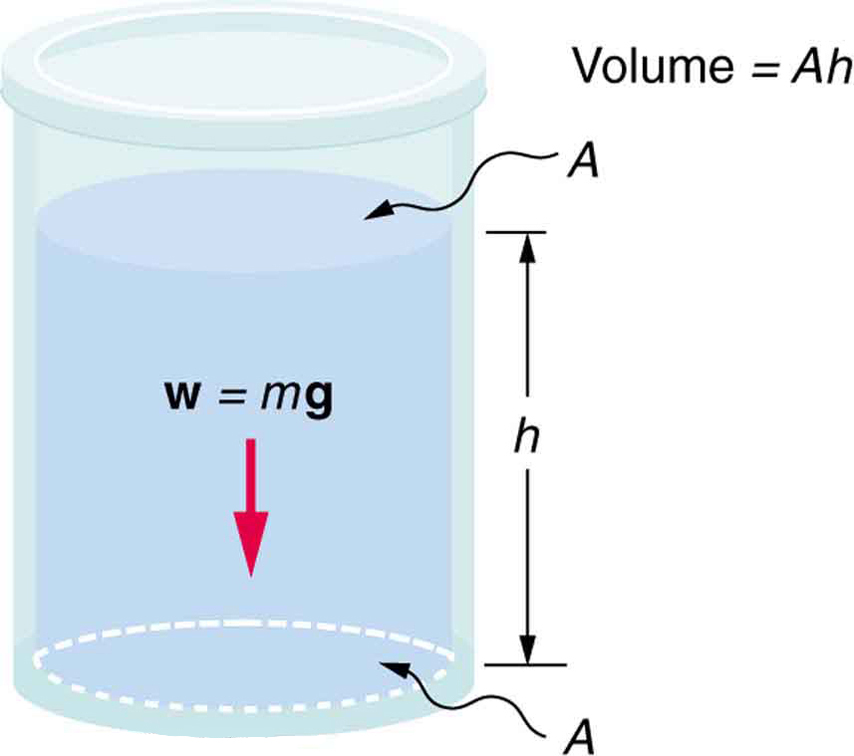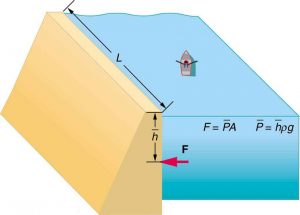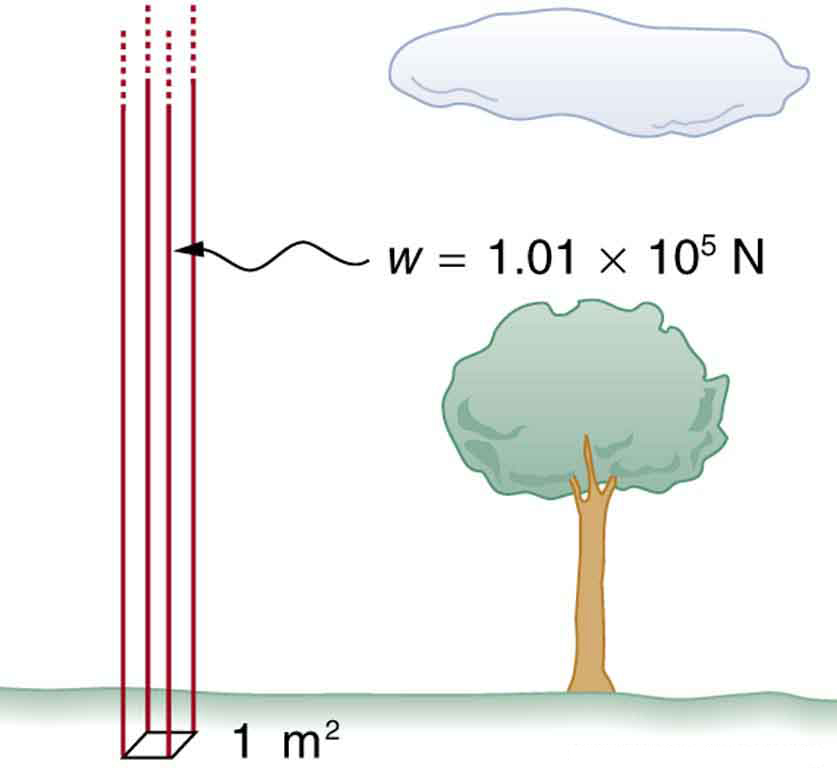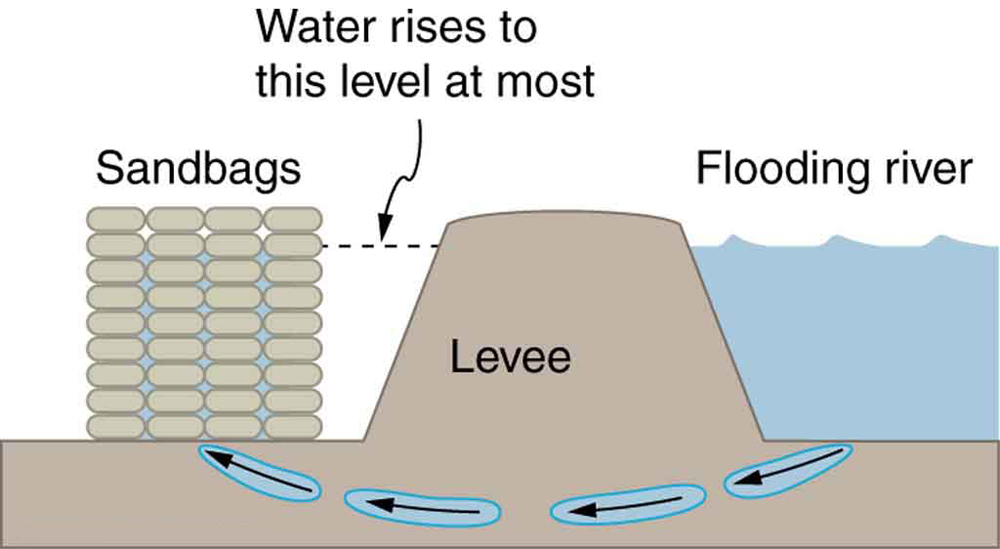Chapter 11 Fluid Statics
78 11.4 Variation of Pressure with Depth in a Fluid
Summary
- Define pressure in terms of weight.
- Explain the variation of pressure with depth in a fluid.
- Calculate density given pressure and altitude.
If your ears have ever popped on a plane flight or ached during a deep dive in a swimming pool, you have experienced the effect of depth on pressure in a fluid. At the Earth’s surface, the air pressure exerted on you is a result of the weight of air above you. This pressure is reduced as you climb up in altitude and the weight of air above you decreases. Under water, the pressure exerted on you increases with increasing depth. In this case, the pressure being exerted upon you is a result of both the weight of water above you and that of the atmosphere above you. You may notice an air pressure change on an elevator ride that transports you many stories, but you need only dive a meter or so below the surface of a pool to feel a pressure increase. The difference is that water is much denser than air, about 775 times as dense.
Consider the container in Figure 1. Its bottom supports the weight of the fluid in it. Let us calculate the pressure exerted on the bottom by the weight of the fluid. That pressure is the weight of the fluid[latex]\boldsymbol{mg}[/latex]divided by the area[latex]\boldsymbol{A}[/latex]supporting it (the area of the bottom of the container):
We can find the mass of the fluid from its volume and density:
The volume of the fluid[latex]\boldsymbol{V}[/latex]is related to the dimensions of the container. It is
where[latex]\boldsymbol{A}[/latex]is the cross-sectional area and[latex]\boldsymbol{h}[/latex]is the depth. Combining the last two equations gives
If we enter this into the expression for pressure, we obtain
The area cancels, and rearranging the variables yields
This value is the pressure due to the weight of a fluid. The equation has general validity beyond the special conditions under which it is derived here. Even if the container were not there, the surrounding fluid would still exert this pressure, keeping the fluid static. Thus the equation[latex]\boldsymbol{P=h\rho{g}}[/latex]represents the pressure due to the weight of any fluid of average density[latex]\boldsymbol{\rho}[/latex]at any depth[latex]\boldsymbol{h}[/latex]below its surface. For liquids, which are nearly incompressible, this equation holds to great depths. For gases, which are quite compressible, one can apply this equation as long as the density changes are small over the depth considered. Example 2 illustrates this situation.

Example 1: Calculating the Average Pressure and Force Exerted: What Force Must a Dam Withstand?
In Chapter 11.2 Example 1, we calculated the mass of water in a large reservoir. We will now consider the pressure and force acting on the dam retaining water. (See Figure 2.) The dam is 500 m wide, and the water is 80.0 m deep at the dam. (a) What is the average pressure on the dam due to the water? (b) Calculate the force exerted against the dam and compare it with the weight of water in the dam (previously found to be[latex]\boldsymbol{1.96\times10^{13}\textbf{ N}}[/latex]).
Strategy for (a)
The average pressure[latex]\boldsymbol{\bar{P}}[/latex]due to the weight of the water is the pressure at the average depth[latex]\boldsymbol{\bar{h}}[/latex]of 40.0 m, since pressure increases linearly with depth.
Solution for (a)
The average pressure due to the weight of a fluid is
Entering the density of water from Table 1 and taking[latex]\boldsymbol{\bar{h}}[/latex]to be the average depth of 40.0 m, we obtain
Strategy for (b)
The force exerted on the dam by the water is the average pressure times the area of contact:
Solution for (b)
We have already found the value for[latex]\boldsymbol{\bar{P}}.[/latex]The area of the dam is[latex]\boldsymbol{A=80.0\textbf{ m}\times500\textbf{ m}=4.00\times10^4\textbf{ m}^2},[/latex]so that
Discussion
Although this force seems large, it is small compared with the[latex]\boldsymbol{1.96\times10^{13}\textbf{ N}}[/latex]weight of the water in the reservoir—in fact, it is only[latex]\boldsymbol{0.0800\%}[/latex]of the weight. Note that the pressure found in part (a) is completely independent of the width and length of the lake—it depends only on its average depth at the dam. Thus the force depends only on the water’s average depth and the dimensions of the dam, not on the horizontal extent of the reservoir. In the diagram, the thickness of the dam increases with depth to balance the increasing force due to the increasing pressure.

Atmospheric pressure is another example of pressure due to the weight of a fluid, in this case due to the weight of air above a given height. The atmospheric pressure at the Earth’s surface varies a little due to the large-scale flow of the atmosphere induced by the Earth’s rotation (this creates weather “highs” and “lows”). However, the average pressure at sea level is given by the standard atmospheric pressure[latex]\boldsymbol{P_{\textbf{atm}}},[/latex]measured to be
This relationship means that, on average, at sea level, a column of air above [latex]\boldsymbol{1.00 \;\textbf{m}^2}[/latex] of the Earth’s surface has a weight of[latex]\boldsymbol{1.01\times10^5\textbf{ N}},[/latex]equivalent to[latex]\boldsymbol{1\textbf{ atm}}.[/latex](See Figure 3.)

Example 2: Calculating Average Density: How Dense Is the Air?
Calculate the average density of the atmosphere, given that it extends to an altitude of 120 km. Compare this density with that of air listed in Table 1.
Strategy
If we solve[latex]\boldsymbol{P=h\rho{g}}[/latex]for density, we see that
We then take[latex]\boldsymbol{P}[/latex]to be atmospheric pressure,[latex]\boldsymbol{h}[/latex]is given, and[latex]\boldsymbol{g}[/latex]is known, and so we can use this to calculate[latex]\boldsymbol{\bar{\rho}}.[/latex]
Solution
Entering known values into the expression for[latex]\boldsymbol{\bar{\rho}}[/latex]yields
Discussion
This result is the average density of air between the Earth’s surface and the top of the Earth’s atmosphere, which essentially ends at 120 km. The density of air at sea level is given in Table 1 as[latex]\boldsymbol{1.29\textbf{ kg/m}^3}[/latex]—about 15 times its average value. Because air is so compressible, its density has its highest value near the Earth’s surface and declines rapidly with altitude.
Example 3: Calculating Depth Below the Surface of Water: What Depth of Water Creates the Same Pressure as the Entire Atmosphere?
Calculate the depth below the surface of water at which the pressure due to the weight of the water equals 1.00 atm.
Strategy
We begin by solving the equation[latex]\boldsymbol{P=h\rho{g}}[/latex]for depth[latex]\boldsymbol{h}:[/latex]
Then we take[latex]\boldsymbol{P}[/latex]to be 1.00 atm and[latex]\boldsymbol{\rho}[/latex]to be the density of the water that creates the pressure.
Solution
Entering the known values into the expression for[latex]\boldsymbol{h}[/latex]gives
Discussion
Just 10.3 m of water creates the same pressure as 120 km of air. Since water is nearly incompressible, we can neglect any change in its density over this depth.
What do you suppose is the total pressure at a depth of 10.3 m in a swimming pool? Does the atmospheric pressure on the water’s surface affect the pressure below? The answer is yes. This seems only logical, since both the water’s weight and the atmosphere’s weight must be supported. So the total pressure at a depth of 10.3 m is 2 atm—half from the water above and half from the air above. We shall see in Chapter 11.5 Pascal’s Principle that fluid pressures always add in this way.
Section Summary
- Pressure is the weight of the fluid[latex]\boldsymbol{mg}[/latex]divided by the area[latex]\boldsymbol{A}[/latex]supporting it (the area of the bottom of the container):
[latex]\boldsymbol{P\:=}[/latex][latex]\boldsymbol{\frac{mg}{A}}.[/latex]
- Pressure due to the weight of a liquid is given by
[latex]\boldsymbol{P=h\rho{g}},[/latex]
where[latex]\boldsymbol{P}[/latex]is the pressure,[latex]\boldsymbol{h}[/latex]is the height of the liquid,[latex]\boldsymbol{\rho}[/latex]is the density of the liquid, and[latex]\boldsymbol{g}[/latex]is the acceleration due to gravity.
Conceptual Questions
1: Atmospheric pressure exerts a large force (equal to the weight of the atmosphere above your body—about 10 tons) on the top of your body when you are lying on the beach sunbathing. Why are you able to get up?
2: Why does atmospheric pressure decrease more rapidly than linearly with altitude?
3: What are two reasons why mercury rather than water is used in barometers?
4: Figure 4 shows how sandbags placed around a leak outside a river levee can effectively stop the flow of water under the levee. Explain how the small amount of water inside the column formed by the sandbags is able to balance the much larger body of water behind the levee.

5: Why is it difficult to swim under water in the Great Salt Lake?
6: Is there a net force on a dam due to atmospheric pressure? Explain your answer.
7: Does atmospheric pressure add to the gas pressure in a rigid tank? In a toy balloon? When, in general, does atmospheric pressure not affect the total pressure in a fluid?
8: You can break a strong wine bottle by pounding a cork into it with your fist, but the cork must press directly against the liquid filling the bottle—there can be no air between the cork and liquid. Explain why the bottle breaks, and why it will not if there is air between the cork and liquid.
Problems & Exercises
1: What depth of mercury creates a pressure of 1.00 atm?
2: The greatest ocean depths on the Earth are found in the Marianas Trench near the Philippines. Calculate the pressure due to the ocean at the bottom of this trench, given its depth is 11.0 km and assuming the density of seawater is constant all the way down.
3: Verify that the SI unit of[latex]\boldsymbol{h\rho{g}}[/latex]is[latex]\boldsymbol{\textbf{N/m}^2}.[/latex]
4: Water towers store water above the level of consumers for times of heavy use, eliminating the need for high-speed pumps. How high above a user must the water level be to create a gauge pressure of[latex]\boldsymbol{3.00\times10^5\textbf{ N/m}^2}?[/latex]
5: The aqueous humor in a person’s eye is exerting a force of 0.300 N on the[latex]\boldsymbol{1.10-\textbf{cm}^2}[/latex]area of the cornea. (a) What pressure is this in mm Hg? (b) Is this value within the normal range for pressures in the eye?
6: How much force is exerted on one side of an 8.50 cm by 11.0 cm sheet of paper by the atmosphere? How can the paper withstand such a force?
7: What pressure is exerted on the bottom of a 0.500-m-wide by 0.900-m-long gas tank that can hold 50.0 kg of gasoline by the weight of the gasoline in it when it is full?
8: Calculate the average pressure exerted on the palm of a shot-putter’s hand by the shot if the area of contact is[latex]\boldsymbol{50.0\textbf{ cm}^2}[/latex]and he exerts a force of 800 N on it. Express the pressure in[latex]\boldsymbol{\textbf{N/m}^2}[/latex]and compare it with the[latex]\boldsymbol{1.00\times10^6\textbf{ Pa}}[/latex]pressures sometimes encountered in the skeletal system.
9: The left side of the heart creates a pressure of 120 mm Hg by exerting a force directly on the blood over an effective area of[latex]\boldsymbol{15.0\textbf{ cm}^2}.[/latex]What force does it exert to accomplish this?
10: Show that the total force on a rectangular dam due to the water behind it increases with the square of the water depth. In particular, show that this force is given by[latex]\boldsymbol{F=\rho{g}h^2\:L/2},[/latex]where[latex]\boldsymbol{\rho}[/latex]is the density of water,[latex]\boldsymbol{h}[/latex]is its depth at the dam, and[latex]\boldsymbol{L}[/latex]is the length of the dam. You may assume the face of the dam is vertical. (Hint: Calculate the average pressure exerted and multiply this by the area in contact with the water. (See Figure 5.)

Glossary
- pressure
- the weight of the fluid divided by the area supporting it
Solutions
Problems & Exercises
1:
0.760 m
3:
[latex]\begin{array}{lcl} \boldsymbol{(h\rho{g})_{\textbf{units}}} & \boldsymbol{=} & \boldsymbol{(\textbf{m})(\textbf{kg/m}^3)(\textbf{m/s}^2)=(\textbf{kg}\cdotp\textbf{m}^2)/(\textbf{m}^3\cdotp\textbf{s}^2)} \\ {} & \boldsymbol{=} & \boldsymbol{(\textbf{kg}\cdotp\textbf{m/s}^2)(1\textbf{/m}^2)} \\ {} & \boldsymbol{=} & \boldsymbol{\textbf{N/m}^2} \end{array}[/latex]
5:
(a) 20.5 mm Hg
(b) The range of pressures in the eye is 12–24 mm Hg, so the result in part (a) is within that range
7:
[latex]\boldsymbol{1.09\times10^3\textbf{ N/m}^2}[/latex]
9:
24.0 N

